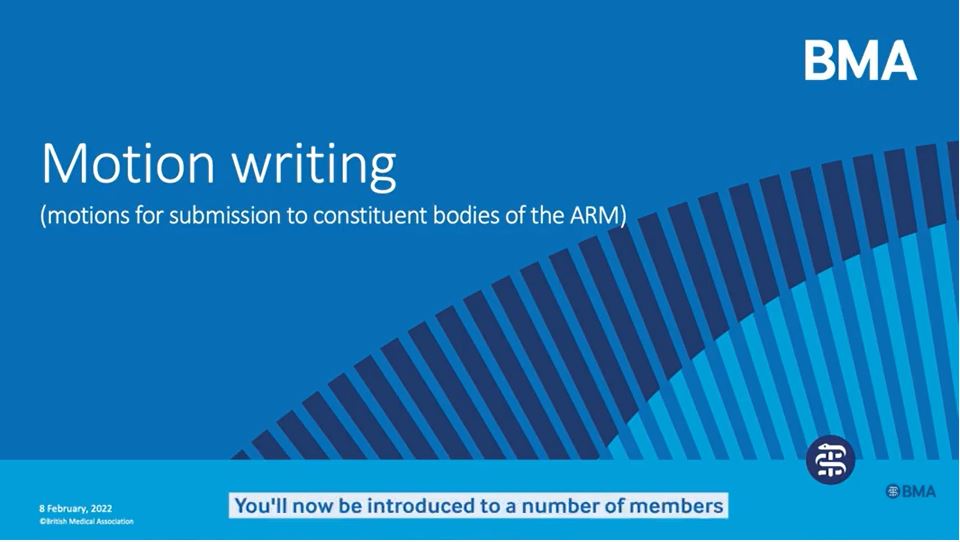The RB (Representative body), which consists of delegates from all BMA divisions and branches of practice, regional and national councils, meets each year at ARM to form BMA's policy.
When a motion is passed at ARM, it is handed to the appropriate body for implementation and it ultimately becomes BMA policy.
Top tips for writing a good motion

Your motion is more likely to be chosen if it comes with a call for action that the Association or branch of practice can take forward.
When writing your motion, make sure it is:
- topical, accurate and concise
- comprehensible and logical
- likely to prompt good debate in a subject area on which it is desirable for the BMA to develop or change policy.
Motions should be clear statements which essentially cover:
- the problem which needs to be solved (welcomes, regrets, deplores, denounces)
- the principle which underlies the solution (reaffirm, recognise, declare)
- the proposal at the heart of the motion (affirms, believes, recommends, urges)
- start your motion with the words "That this conference..."
Equality considerations and evaluating the potential for discrimination for your proposed motion
Meaningful consideration must be given to how to both avoid creating discriminatory policy outcomes and to ensuring that the process of policy development does not involve negative or discriminatory practices.
When drafting the text for you proposed motion work through the following questions:
1. What are the intended consequences of this motion?
2. Does it breach or potentially breach, or offend established codes, standards, and legislation?
Including but not limited to:
- The BMA Code of Conduct incorporated the BMA’s values and behaviour principles.
- The Equality Act 2010 and other equalities and human rights legislation
- European Convention on Human Rights
- Employment Law
- Criminal law e.g. hate crime
- GMC standards for doctors e.g. Good Medical Practice (updated 2024)
Members can propose motions that challenge any of these standards. But there should be consideration of the potential for unlawful discrimination.
3. How might the implementation of the proposed motion impact negatively on individuals or groups with protected characteristics?
4. Could the proposed motion contribute to inequality, or disadvantage or discriminate against any individuals or groups with protected characteristics?
5. Will the activity of communication about this motion have a negative impact on a group of individuals?
6. Could the motion give rise to a reasonable perception that the motion is discriminatory even if it may not ultimately be discriminatory?
The protected characteristics are age, gender reassignment, being pregnant or on maternity leave, disability, race (including colour, nationality, ethnic or national origin); religion or belief, sex and sexual orientation. Case law has also determined that the following characteristics are also covered, caste, ethical veganism, non-binary and gender fluidity. Discrimination law is covered in the Human Rights Act 1998 and the Equality Act 2010 in England, Wales and Scotland with similar legislation in Northern Ireland (with the addition of political opinion as a protected characteristic).
Read more about the BMA and EDI in the BMA corporate equality, diversity and inclusion strategy 2022-25.
If you have any questions about equality considerations, please do get in touch with the Corporate EDI team ([email protected]) or the policy EIC team ([email protected]).
Have you explored any patient considerations for your proposed motion:
- Have you considered the impact your proposed motion will have on patients accessing and receiving care?
- Have you considered if your proposal could impact negatively or disadvantage some groups of patients and if so, does your proposal contain actions to mitigate against this?
If you have any questions about the impact your motion will have on patients please get in touch with PLG by emailing [email protected]
- Choose issues which are topical and new and not a repeat of existing policy check the existing policy database before submitting any motion.
- Include a proposal of action as this is far more useful in shaping policy and therefore makes a better motion.
- Use sections if you have several clear calls for action. As each section is voted on separately this allows for motions which may contain a controversial element.
- Ensure that any subsections of a motion only deal with one point of principle and don't reference other subsections as they may be divided by the agenda committee.
- Be concise and clear - write in plain English, explain any abbreviations and try not to go above 150 words.
- Ask for help if you're struggling - the agenda committee can or specialty committee rep are there to assist you, so send through your ideas, drafts and questions - it's what they are there for.
- Be original - conferences need exciting, topical debates, even if your motion fails it can still offer the conference a valuable perspective.
- Write long, verbose speeches or be repetitive, vague or didactic.
- Include quotations or actual sums of money both of which run the danger of being inaccurate and thus invalidating the motion.
- Include motions which are already policy.
- Submit a motion with more than three parts (excluding the stem) as these will very rarely be accepted. This is at agenda committee discretion and they can disallow motions.
- Be afraid to submit a motion. They are key to us developing and shaping BMA policy into the future.
Submitting motions to ARM 2024
The ARM 2024 will be held on 24 and 25 June 2024. Further details to follow.
Deadline
The deadline to submit motions is 9am on 2 April 2024.
A sample motion
Below is an example of a previous motion, to give you an idea of the language and construction to use when writing your motion.
"That this Conference notes with dismay the inability of the National Health Service to accommodate recent outbreaks of seasonal disorders, and the resulting threats to ongoing health provision for all citizens and calls upon the Government to redress this appalling situation by:
i) Providing an immediate cash injection to underwrite an increase in high-dependency beds in all regions of the UK
ii) Funding critical care training for enough nursing staff to support the additional high dependency beds
iii) Guaranteeing to improve salaries, conditions and career prospects for nurses
iv) Taking urgent measures to attract back nurses who have left the profession"
or
"That this conference is extremely concerned at the introduction of post-CCT fellowship posts and demands that these:
i) have defined training objectives that genuinely cannot be provided within CCT
ii) be created only to meet a proven and unmet need for consultants with particular sub-specialist skills
iii) be without service commitment
iv) not continue beyond 2010"
How to submit a motion
Please be aware that motion deadlines occur approximately two to three months previous to conferences taking place.
Motions must be submitted in advance by Medical staff and regional consultants committees.
Members can submit motions via their RJDC representatives.
Motions for COMAR are submitted by MASC and its subcommittees or any representative to the conference by advance email.
Each UK medical school, MSC subcommittees, Regional Services Liaison Group, MSC (including co-optees) and devolved committees can submit motions via designated representatives.
Motions by anyone attending the conference can be submitted to the PHMC secretariat. If you cannot attend but wish to submit a motion, it is encouraged to ask a colleague to submit a motion in their name.
Motions can be submitted via regional and national SASCs to the SASC Agenda Committee.
Motions can be submitted via the LMCs (Local medical committees) and their conference representatives.
Motions can be submitted via the JMF (Junior member forum) and their conference representatives.
Members can submit motions via the designated retired members conference representatives.
Motions may only be submitted by honorary secretaries of BMA divisions and regional councils.
Contact the motion advisory service
This motion advisory service provides:
- advice
- facts and figures or information on existing policy
- helps you submit your motion correctly for consideration.
Please include your name, membership number, branch of practice and nation when contacting us, so we can respond to your enquiry as soon as possible.
Contact the motion advisory service via [email protected].

